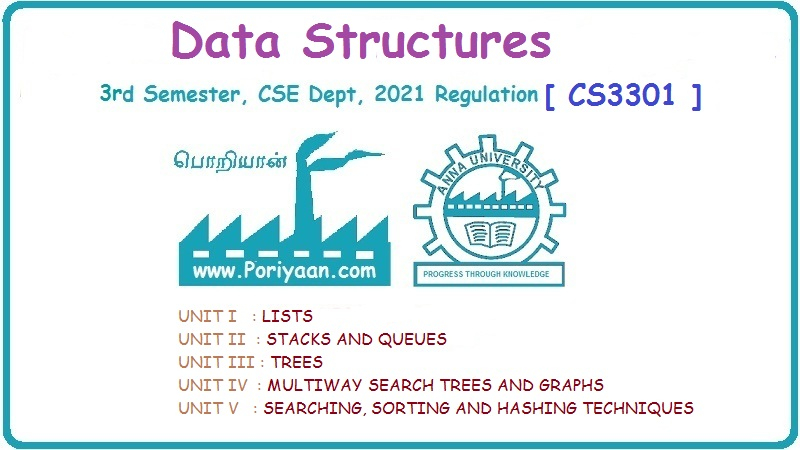Data Structure: Unit IV : Multiway Search Trees and Graphs
B-Tree
Operations, properties, Algorithm | Data Structure
B-tree is a specialized multiway tree used to store the records in a disk. There are number of subtrees to each node.
UNIT IV
CHAPTER 5 : Multiway Search Trees and Graphs
Part I:
Multiway Trees
B-Tree
B-tree
is a specialized multiway tree used to store the records in a disk. There are
number of subtrees to each node. So that the height of the tree is relatively
small. So that only small number of nodes must be read from disk to retrieve an
item. The goal of B-trees is to get fast access of the data.
Multiway search tree
B-tree
is a multiway search tree of order m is an ordered tree where each node has at
the most m children. If there are n number of children in a node then (n - 1)
is the number of keys in the node.
For example:
Following
is a tree of order 4.

From
above tree following observations can be made
1. The
node which has n children posses (n - 1) keys.
2. The
keys in each node are in ascending order.
3. For
every node Node.child [0] has only keys which are less then Node.key [0]
similarly, Node.child [1] has only keys which are greater than Node.key [0]
In other
words, the node at level 1 has F, K and O as keys. At level 2 the node
containing. keys C and D are arranged as child of key F (the cell before F).
Similarly the node containing key G will be child of F but should be attached
after F and before K, as G is between F and K. Here the alphabets F, K, O are
called keys and branches are called children. The B-tree of order m should be
constructed using following properties.
Rule 1:
All the
leaf nodes are on the botom level.
Rule 2:
The root
node should have at least two children.
Rule3;
All the
internal nodes except root node have at least ceil (m/2) nonempty children. The
ceil is a function such that ceil (3.4) = 4, ceil (9.3) = 10, ceil (2.98) = 3
ceil (7) = 7.
Rule 4;
Each
leaf node must contain at least ceil (m/2) - 1 keys.
Insertion
Thus the
B-tree is fairly balanced tree which can be illustrated by following example.
Example of B-tree
We will
consruct a B-tree of order 5 following numbers.
3, 14,
7, 1, 8, 5, 11, 17, 13, 6, 23, 12, 20, 26, 4, 16, 18, 24, 25, 19.
The
order 5 means at the most 4 keys are allowed. The internal node should have at
least 3 nonempty children and each leaf node must contain at least 2 keys..
Step 1: Insert 3, 14, 7, 1 as
follows.

Step 2: If
we insert 8 then we need to split the node 1, 3, 7, 8, 14 at medium.

Step 3: Insert
5, 11, 7 which can be easily inserted in a B-tree.

Step 4 :
Now
insert 13. But if we insert 13 then the leaf node will have 5 keys which is not
allowed. Hence 8, 11,13, 14, 17 is split and medium node 13 is moved up.

Step 5:
Now
insert 6, 23, 12, 20 without any split.
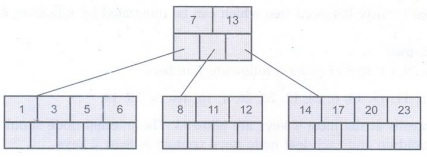
Step 6: The 26 is inserted to the
rightmost leaf node. Hence 14, 17, 20, 23, 26 the node is split and 20 will be
moved up.

Step 7: Insertion of node 4 causes
left most node to split. The 1, 3, 4, 5, 6 causes key 4 to move up. Then insert
16, 18, 24, 25.

Step 8: Finally insert 19. Then 4,
7, 13, 19, 20 needs to be split. The median 13 will be moved up to form a root
node.
The tree
then will be -
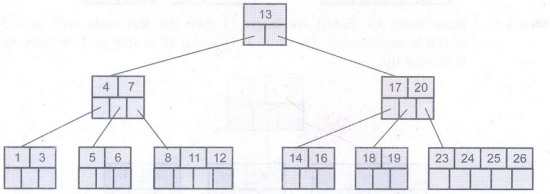
Thus the
B-tree is constructed.
Ex. 5.1.1 Distinguish between B Tree and B+
Tree. Create a B three of order 5 by inserting the following elements: 3,14,7,1,8,5,11,17,13,6,23,12,20,26,4,16,18,24,25
and 19.
Sol. :

Example: Creation of B tree - Refer section
5.1.1.
Algorithm for insertion in B-tree
Algorithm
insert (root, key)
{
//
Problem Description: This algorithm is for
//
inserting key node in B-tree.
temp ←root
if
(n[temp]=2t 1) then
s←get_node
() // memory is allocated.
{
roots←s
leaf [s]
←FALSE
n [s] ←0
child1[s]
←root
split_child
(s, 1, root)
Insert_In
(s, key)
}
Else
Insert_In
(s, key)
}
Deletion
Consider
a B-tree
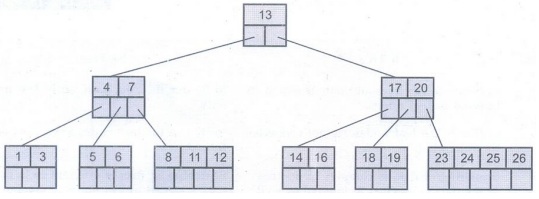
If we
want to delete 8 then it is very simple

Now we will
delete 20, the 20 is not in a leaf node so we will find its successor which is
23. Hence 23 will be moved up to replace 20.
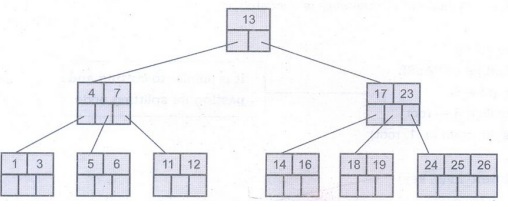
Next we
will delete 18. Deletion of 18 from the corresponding node causes the node with
only one key, which is not desired (as per rule 4) in B-tree of order 5. The
sibling node to immediate right has an extra key. In such a case we can borrow
a key from parent and move spare key of sibling to up. See the following
figure.
Now
delete 5. But deletion of 5 is not easy. The first thing is 5 is from leaf
node. Secondly this leaf node has no extra keys nor siblings to immediate left
or right. In such a situation we can combine this node with one of the
siblings. That means remove 5 and combine 6 with the node 1, 3. To make the
tree balanced we have to move parent's key down. Hence we will move 4 down as 4
is between 1, 3 and 6. The tree will be

But
again internal node of 7 contains only one key which not allowed in B-tree (as
per rule 3). We then will try to borrow a key from sibling. But sibling 17, 24
has no spare key. Hence what we can do is that, combine 7 with 13 and 17, 24.
Hence the B-tree will be

Ex. 5.1.2: Construct a B-tree with order m = 3
for the key values 2,3,7,9,5,6,4,8,1 and delete the values 4 and 6. Show the
tree in performing all operations.
Sol. The order m = 3 means at
the most 2 keys are allowed. The insertion operation is as follows:

Step 6: Insert 4. This will make a
sequence 4,5, 6. The 5 will go up. Then the sequence will become 3,5, 7. Again
5 will go up.

Step 8; Delete
4 and 6. As these are the leaf nodes without any adjacent key. Their deletion
is very simple. Just make these node as NULL. The remaining adjustment will
occur. The resultant B-tree will be,

Searching
The
search operation on B-tree is similar to a search on binary search tree.
Instead of choosing between a left and right child as in binary tree, B-tree makes
an m-way choice. Consider a B-tree as given below
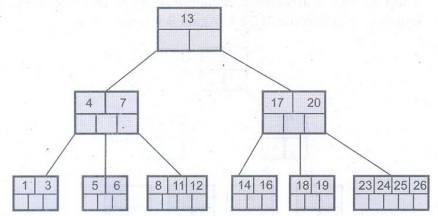
If we
want to search node 11 then
i) 11 13
Hence search left node
ii) 11
> 7: Hence rightmost node
iii) 11
> 8, move in second block
iv) node
11 is found.
The
running time of search operation depends upon the height of the tree. It is
O(log n).
Algorithm
The
algorithm for searching a target node is as follows
Algorithm
Search (temp, target)
{
//
Problem Description: This algorithm is for
//
searching the 'target' node
i ←1
while i←i + 1
((i≤n[temp]) AND (target
> key; [temp]))
if ((i≤n[temp]) AND (target ==key.[temp]))
return
(temp, i)
if (leaf
[temp]==TRUE) then
return
NULL
else
READ (Ci [temp])
return
search ((Ci [temp], target)
}
The
search operation on B-tree is similar to a search operation on a binary tree.
The desired child is chosen by performing linear search of values in the node.
The running time of this algorithm is O(log n).
Height of B-Tree
The
maximum height of B-tree gives an upper bound on number of disk access. The
minimum number of keys in a B-tree of order 2m and depth h is
1 + 2m +
2m(m + 1) + 2m(m+1)2 + ... +2m(m+1)h-1

The
maximum height of B-tree with n keys
logm+1
n/ 2m = O(logn)
Review Questions
1. Explain the properties of B-trees.
2. Explain the insertion and deletion
of nodes in the B-trees with suitable example.
3. What is a B-tree? Mention the
properties that a B-tree holds.
Data Structure: Unit IV : Multiway Search Trees and Graphs : Tag: : Operations, properties, Algorithm | Data Structure - B-Tree
Related Topics
Related Subjects
Data Structure
CS3301 3rd Semester CSE Dept | 2021 Regulation | 3rd Semester CSE Dept 2021 Regulation
